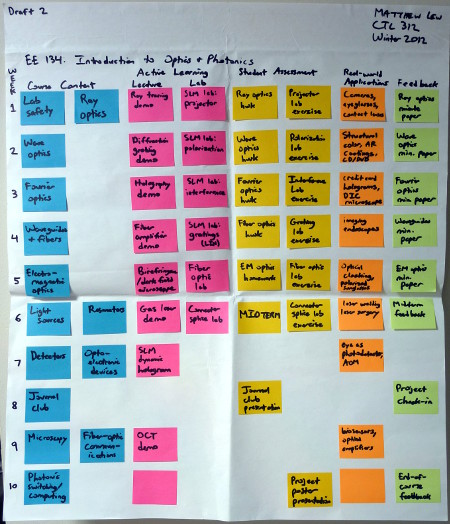Introduction to Photonics
Pedagogy is rarely addressed as part of graduate training, especially in science and engineering. Graduate students jump through the traditional hoops of holding office hours, grading, and maybe even giving a review session as teaching assistants, but few get the opportunity to practice teaching. How can Associate Professors approach teaching his/her first class on a new campus sorely lacking in this professional training? Taking "Science and Engineering Course Design" and designing the undergraduate course "Introduction to Photonics" with Professor Audrey Ellerbee in the winter and spring of 2012 addressed this deficiency in my graduate education. It was a remarkably rewarding and eye-opening experience.
- On this page:
- Importance
- Tasks completed
- Skills gained
- Lessons learned
- Impact
Importance
Teaching is the core mission of institutions of higher learning. It is how the young minds of tomorrow are trained to solve the important problems of the future. This can't be done with ineffective teachers. Naturally, a class on course design enables graduate students and researchers to evolve from the amateur ranks into professional teachers. The experience of designing a course alongside Prof. Ellerbee gave me valuable practice in my journey toward mastering these skills.
Tasks completed
- Became familiar with current educational literature, regarding both engineering education in general and optics education in particular
- Designed course to emphasize mastery by setting clear goals for skills students should learn, having students practice these skills through homework and lab exercises, and giving adequate feedback on these exercises; also addressed student motivation by emphasizing real-world applications of topics covered in class
- Co-wrote course "blurb" with Prof. Ellerbee
EE 134: Introduction to Photonics
Photonics, optical components, and fiber optics. Conceptual and mathematical tools for design and analysis of optical communication, sensor and imaging systems. Experimental characterization of semiconductor lasers, optical fibers, photodetectors, receiver circuitry, fiber optic links, optical amplifiers, and optical sensors. Class project on confocal microscopy or other method of sensing or analyzing biometric data. Laboratory experiments. - Co-wrote course syllabus with Prof. Ellerbee. The syllabus is based on sound practices of course design, focuses on student learning, and helps meet course goals.
- Taught one week of lectures (3 hours) on wave optics, including writing and administering in-class active learning exercises
Skills gained
- Adopted "How Learning Works" principles for improving student
learning
- Students' prior knowledge can help or hinder learning.
- How students organize knowledge influences how they learn and apply what they know.
- Students' motivation determines, directs, and sustains what they do to learn.
- To develop mastery, students must acquire component skills, practice integrating them, and know when to apply them.
- Goal-directed practice coupled with targeted feedback enhances the quality of students' learning.
- Students' current level of development interacts with the social, emotional, and intellectual climate of the course to impact learning.
- To become self-directed learners, students must learn to monitor and adjust their approaches to learning.
- Applied ideas of "backwards course design" when designing "Introduction to
Photonics"
Begin with the desired learning goals and outcomes of the course →Leads to skills that students need to acquire and master →Drives the content, class format, and assessment format of the course →Finally, the syllabus can be written once all of these details are complete.
- Analyzed a broad range of teaching styles
- Learned how to become an effective teacher by applying relevant learning research, practicing teaching, obtaining feedback, and developing habits of self-reflection and growth
Lessons learned
- Teaching is a full-time job. It needs one's full scholarly attention to be done effectively: be cognizant of current research on education, practice often, and obtain feedback!
- There are sound principles to be used when designing a course beyond just following a textbook. "Backwards course design" allows one to rationally make decisions about content, format, and assessments in order to achieve a set of learning goals.
- I learned that I enjoy the challenge and process of teaching!
Impact
The knowledge and skills I gained from taking "Science and Engineering Course Design" fundamentally shapes my teaching philosophy and will impact every teaching task I will ever undertake. Furthermore, the opportunity to work one on one with a professor to design a course from the ground up was a fun, challenging experience that influences my own desire to become a professor that both runs a research lab and teaches courses. Finally, this experience has introduced me to the world of engineering education, which I now follow with interest.
"Introduction to Photonics" sample course materials:
Further reading:
- S. A. Ambrose, How Learning Works: Seven Research-based Principles for Smart Teaching. San Francisco, CA: Jossey-Bass, 2010.
- R. M. Felder, D. R. Woods, J. E. Stice, and A. Rugarcia, "The future of engineering education II. Teaching methods that work," Chem. Engr. Education 34, 26 (2000). [PDF]
- Education and Training in Optics and Photonics (ETOP) conference proceedings
- M. F. Masters and T. T. Grove, "Active learning in intermediate optics through class tutorials and concept building laboratories," Education and Training in Optics and Photonics, paper ESCB6 (2009). [Journal]
